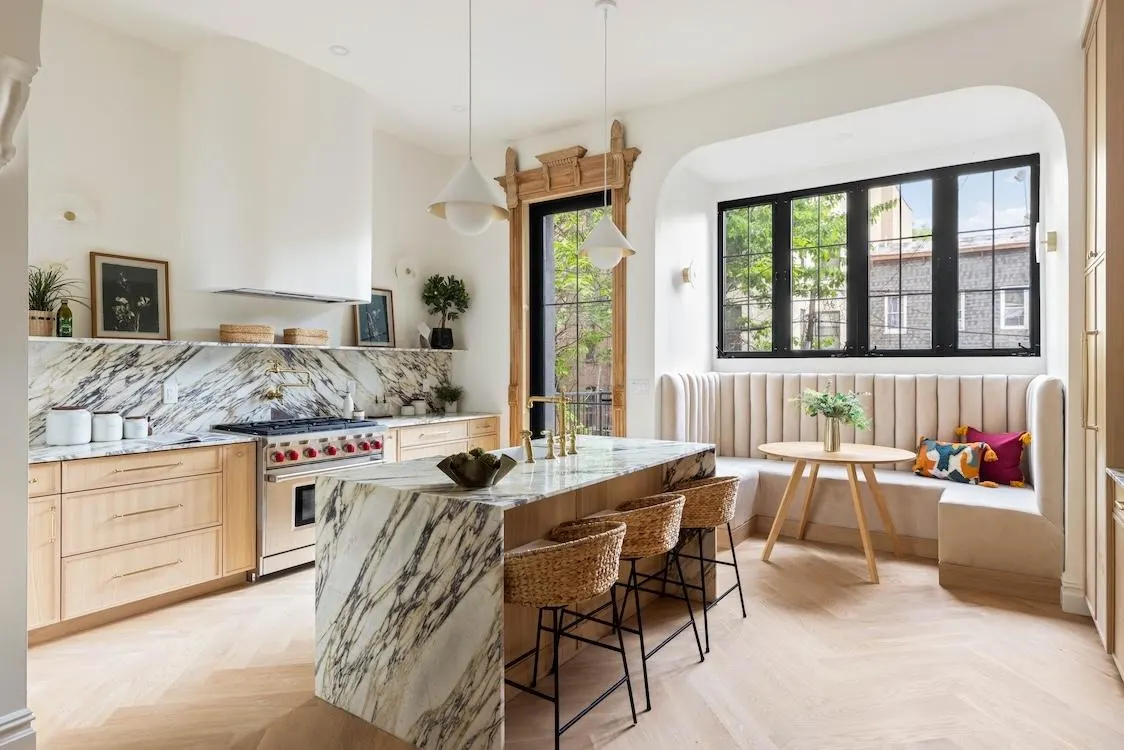Copyright forbes

757 Putnam Avenue in Brooklyn, re-designed by Bolt Equities Hailey Ellen Day With an uncertain housing market, many potential sellers are staying put, choosing to improve what they already have rather than taking on the challenges of buying and selling. But not every renovation is a wise investment. So how can homeowners make smart renovation choices that maximize long-term returns? Here’s what industry experts recommend. Think Of Renovations Like A High-Yield Savings Account Planning renovations can feel overwhelming, but according to interior designer, HGTV star, and former Goldman Sachs executive, Galey Alix, the best way to make the right choices is to view home improvement projects like a high-yield savings account. “The tried and forever true term that comes to mind is 'compounding.' The beauty of a high-yield savings account is that every month your current savings generate a small return (depending on the current market environment, typically somewhere between 2.5 to 5 percent). And while it might not sound like much, where you win is in the compounding nature of these small monthly interest payments being reinvested back into your account.” Over time these small gains add up. “A lower yielding interest payment could equate to updating all of your light switch cover plates or repainting your baseboards. A higher yielding payment could equate to replacing all of your floors or fully renovating a bathroom,” explains Alix. “While you won't reap the reward monthly, such as in a savings account, the payment will come in one lump sum down the road in the form of a higher offer when you list your home.” Focus On High-Impact Spaces While remodeling can be time-consuming and costly, Alix notes that certain spaces almost always pay off. “Kitchens and primary bathrooms typically require the most demolition, disrupt the homeowners’ lives the most, and incur the highest costs. For these reasons, focusing your renovation efforts on these two spaces will be money and sweat equity well spent.” MORE FOR YOU A custom primary closet can also be worth the investment. “Many homes don't have updated or expansive closets because custom closets aren't cheap. For that reason, it's a nice selling point when it comes time to list your property.” Updating flooring is another high-value move that can instantly elevate the entire home, especially since most homeowners replace flooring throughout all rooms at once. “This is the quickest way to refresh your entire home without having to re-design and gut every room,” adds Alix. Don’t Underestimate Small, Strategic Updates However, seeing returns isn’t always the result of a full gut renovation. Mike Martirena of the Ivan & Mike Team at Compass advises focusing on smaller, budget-conscious upgrades. “Updating kitchen elements such as new cabinet doors, hardware, and backsplashes can also enhance the space.” If cabinets are in good shape, painting them can make a major impact for a fraction of the cost of replacement. Repainting any room also goes a long way toward modernizing a space. After all, nothing looks less stylish or turns off buyers faster than chipped paint, cracked walls, or dated color choices like an orange kitchen. Don’t Forget The Non-Cosmetic Improvements Cosmetic upgrades get attention, but behind-the-scenes improvements often yield significant resale value. Lisa Simonsen of Brown Harris Stevens recommends focusing on mechanical and system updates. “Major system improvements like central air, upgraded electrical, or plumbing enhancements add both comfort and resale value.” However, the practicality of specific amenities can be location-dependent. For example, Simonsen tells me “In markets like New York City, adding a washer and dryer can significantly broaden your buyer pool, since many older buildings lack in-unit laundry,” adds the broker. Energy efficiency is also an increasingly important selling point. “Installing energy-efficient windows, improved insulation, heat pumps, or solar panels can lower utility costs and often qualify for tax incentives. These upgrades appeal strongly to eco-conscious buyers,” states Simonsen. Renovate All At Once If Possible While some homeowners prefer to tackle renovations in stages, Alix tells me completing everything at once is the smarter move. “The benefit to renovating a space in its entirety at once is that it's more efficient because you only have to live through the mess once, and if you're outsourcing tradespeople like electricians and installers, their cost will be less as it requires fewer trips to your home. Additionally, there are things you want to catch in real time that are difficult to catch when you space out your timeline,” she explains. This advice is practical as well as financial. “For example, if you want to redo your floors first and add new kitchen cabinets six months later, the shape of the new kitchen might require additional flooring to be laid. Because you waited six months, the new flooring you need to install where the shape of your kitchen changed may not match the existing floors because they haven't had the same sun exposure for the last six months.” For homeowners without the budget to complete everything at once, Alix suggests saving and planning so the project can eventually be executed in one comprehensive phase. Renovations That Rarely Pay Off But, some projects simply don’t justify the cost. “Over-personalization, such as themed rooms, highly specific layouts (like converting a maid's room into a wine cellar or drastically reconfiguring a four-bedroom house into a home with fewer rooms or a smaller home, elaborate dressing rooms and ornate offices), and luxury or niche installations (like aquariums or home theaters) rarely pay off,” says Martirena. “These types of renovations often appeal to a narrow audience and can even deter future buyers who may see them as something they'll have to undo,” warns the broker. Similarly, over-the-top amenities such as elaborate pools, extensive hard-to-maintain landscaping, or converting basements into gyms or wine cellars don’t end up paying off in the long run. One space to keep simple? The bedroom. “Bedrooms are the easiest room to make cosmetic updates,” reveals developer Joshua Yaghoubzadeh of Bolt Equities. “I don’t advise investing in extensive renovations in bedrooms because buyers know that furniture and decor complete the space.” Small cosmetic touches like repainting and updating light fixtures can freshen up a bedroom without overspending. Ultimately, the smartest renovations aren’t always the flashiest ones, they’re the updates that blend functionality and aesthetics. Whether it’s a refreshed kitchen, upgraded systems, or simply a new coat of paint, every improvement should be viewed of a larger investment strategy. After all, as Alix reminds says, “We should all be looking at our home renovations through the same compounding lens.” Editorial StandardsReprints & Permissions



